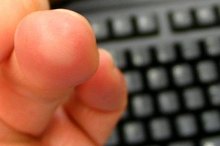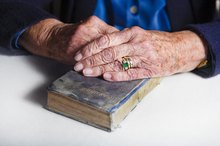What does fact checked mean?
At Healthfully, we strive to deliver objective content that is accurate and up-to-date. Our team periodically reviews articles in order to ensure content quality. The sources cited below consist of evidence from peer-reviewed journals, prominent medical organizations, academic associations, and government data.
The information contained on this site is for informational purposes only, and should not be used as a substitute for the advice of a professional health care provider. Please check with the appropriate physician regarding health questions and concerns. Although we strive to deliver accurate and up-to-date information, no guarantee to that effect is made.
How to Stop the Bleeding of a Cherry Angioma
Cherry angiomas are benign skin growths that can be red or purplish in appearance 1. Angiomas are caused by an accumulation of capillaries underneath your skin. According to the website Medline Plus, cherry angiomas become common in adults over 30 1. In many instances, an angioma will never need to be treated. However, a large cherry angioma can bleed profusely when it is injured or just scratched. If you run into an issue where you can't contain an angioma's bleeding, you should seek treatment.
Stopping the Bleeding
Apply pressure to the site of the angioma with a hand towel. The pressure should be firm.
Complications of Endovenous Laser Treatment
Learn More
Hold pressure on the affected area for up to 15 minutes. Don't remove the towel during this time, in order to give the affected area time to clot.
Remove the towel after 15 minutes to determine if the site is still bleeding. If the site has stopped bleeding, clean the area with a cotton ball dipped in hydrogen peroxide. Apply an antibiotic ointment such as Neosporin to the site, and bandage the wound. Change the bandages every 3 to 4 hours.
Abnormal Bleeding After a D&C
Learn More
If the bleeding does not stop, get the angioma treated. According to Medline Plus, angiomas that bleed often can be treated with electrosurgery 1. Electrosurgery uses an electrode that touches the bleeding site to help the tissue coagulate and stop the angioma's bleeding in a process known as electrocoagulation 2.
If you suffer from frequent bleeding of your angioma, consider getting the tissue removed. According to the medical journal American Family Physician, a process known as electrosection can remove the affected tissue with an electrode. Electrosection can remove the tissue with minimal damage to your skin.
Tips
See a dermatologist if you can't stop your angioma from bleeding.
Warnings
Don't pick at your angioma. This can lead to an infection and possible scarring of the affected area. Don't try to remove an angioma yourself. This should be done by a dermatologist.
- Apply pressure to the site of the angioma with a hand towel.
Related Articles
References
- Medline Plus: Cherry Angiomas
- AAFP: Electrosurgery for Cherry Angioma
- Darjani A, Rafiei R, Shafaei S, et al. Evaluation of lipid profile in patients with cherry angioma: A case-control study in Guilan, Iran. Dermatol Res Pract. 2018;2018:4639248. doi:10.1155/2018/4639248
- Plunkett A, Merlin K, Gill D, Zuo Y, Jolley D, Marks R. The frequency of common nonmalignant skin conditions in adults in central Victoria, Australia. Int J Dermatol. 1999;38(12):901-8. doi:10.1046/j.1365-4362.1999.00856.x
- Askari N, Vaez-mahdavi MR, Moaiedmohseni S, et al. Association of chemokines and prolactin with cherry angioma in a sulfur mustard exposed population--Sardasht-Iran cohort study. Int Immunopharmacol. 2013;17(3):991-5. doi:10.1016/j.intimp.2012.12.016
- American Osteopathic College of Dermatology. Angiomas.
- MedlinePlus. Cherry angioma. Updated October 14, 2018.
- Nicklaus Children’s Hospital. Cherry angiomas. Updated July 2017.
Tips
- See a dermatologist if you can't stop your angioma from bleeding.
Warnings
- Don't pick at your angioma. This can lead to an infection and possible scarring of the affected area.
- Don't try to remove an angioma yourself. This should be done by a dermatologist.






